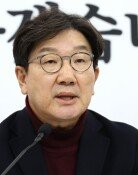U.S. May Capitalize on CIA Report to Place International Pressure on NK
U.S. May Capitalize on CIA Report to Place International Pressure on NK
Posted July. 02, 2003 21:26,
The U.S. government refused on July 1 to elaborate on the report by the CIA that satellites had identified an advanced nuclear testing site in an area called Youngdoktong, not far from Yongbyon in North Korea. Reiterating that the nine-month long nuclear standoff between the U.S. and North Korea should be addressed by peaceful and diplomatic means, it emphasized the severity of the situation stemming from the nuclear standoff.
The CIA report of their find came at a sensitive time when high-ranking officials from South Korea, Japan, and China had been deeply involved in solving the nuclear issue in a peaceful way are in Washington to narrow their differences in approaches to tackle the issue. The CIA`s timely report suggested the U.S. government`s intention of placing increased pressure on the communist regime.
It is widely known that the CIA report was made public with the help of intelligence information provided by the South Korean government last February. The South Korean intelligence agency obtained the information from North Korean defectors and other intelligence sources that “there might be nuclear facilities in Youngdoktong.”
Based on the information, U.S. satellites conducted massive surveillance missions over the country to find concrete evidence. Through spyplane flights, U.S. intelligence agencies confirmed that the site has facilities capable of conducting high explosion tests.
The report said that North Korea could produce three nuclear warheads with the same amount of plutonium with which it has been attempting to build one or two through high explosive testing at the suspected site. In addition, the CIA said that at the site, equipment has been set up to test conventional explosives that, when detonated, could compress a plutonium core and set off a compact nuclear explosion.
The U.S. sent the CIA report to the South Korean and Japanese governments. In its assessment, the U.S. government claimed that the North may have reprocessed hundreds of spent nuclear fuel rods among a collection of 8,000 spent nuclear fuel rods that it might have produced at its resumed nuclear facilities in Yongbyon since last February.
The U.S. government seems to seriously take the CIA report that supports the claim that additional production of weapons-grade plutonium will increase North Korea`s nuclear arsenal.
Against this backdrop, it is expected that Washington may use the report to prove their argument and thus gain an upper hand in pressuring Pyongyang to end its nuclear ambitions.
maypole@donga.com
Headline News
- Joint investigation headquarters asks Yoon to appear at the investigation office
- KDIC colonel: Cable ties and hoods to control NEC staff were prepared
- Results of real estate development diverged by accessibility to Gangnam
- New budget proposal reflecting Trump’s demand rejected
- Son Heung-min scores winning corner kick







